#central european religions
Explore tagged Tumblr posts
Text

🇨🇭 The Gothic Bern Minster (German: Berner Münster) in the Old Town of Bern, Switzerland - coloured aquatint by Gabriel Lory the Elder from around 1810.
The tower looks different nowadays, as its construction was finished only in 1893.
#Gabriel Lory the Elder#Bern#Berne#Switzerland#Schweiz#Swiss#Suisse#Fascinating Europe#Europa#Europe#Architectural Revival#heritage#European Heritage#church#religion#Christianity#Gothic#art#artwork#vintage#oldviews#Berner Münster#aquatint#drawing#19th century#central europe#cityscape#architecture
13 notes
·
View notes
Text
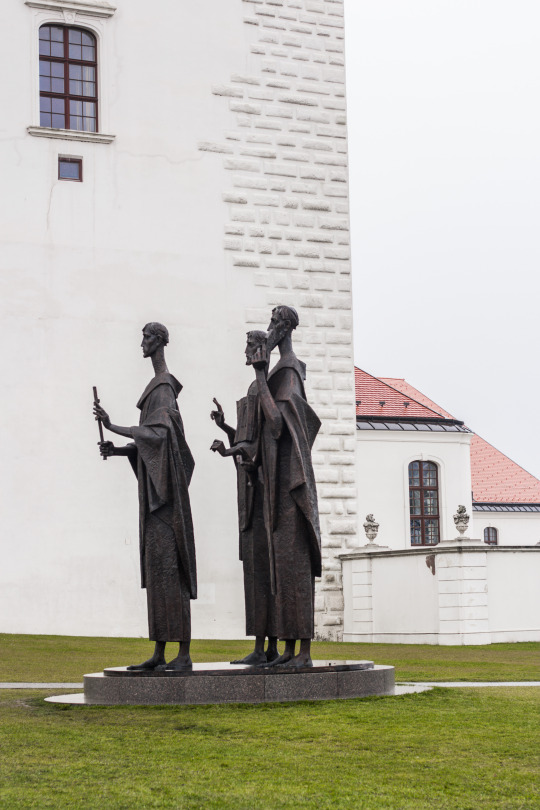
Hrad, Bratislava, Slovakia.
#slovakia#slovakian#slovak#slovensko#bratislava#slav#slavic#europe#central europe#slavic culture#slavic folklore#statue#art#european#culture#visit#trip#50mm#religion#christianity#civilisation#hrad
31 notes
·
View notes
Text
Exploring Bosnia and Herzegovina: A Comprehensive Travel Guide
A Brief History of Bosnia and Herzegovina Bosnia and Herzegovina, nestled in the heart of the Balkans, has a rich and tumultuous history. The region was part of the Roman Empire and later the Byzantine Empire before becoming the medieval Bosnian Kingdom in the 12th century. The Ottoman Empire took control in the 15th century, influencing the culture and religion of the region significantly. In…

View On WordPress
#A Brief History of Bosnia and Herzegovina#A Brief History of Bosnia and Herzegovina Bosnia and Herzegovina#a visa is not required for stays of up to 90 days within a 180-day period. However#adventure#africa#aiming to improve standards and align with European norms. Visa Information For many nationalities#along with the Brčko District. The country continues to navigate its post-war recovery and development#and after World War II#and architectural influences that are still visible today in cities like Sarajevo and Mostar. Political Situation Today#and baklava (sweet pastry). The culture is warm and hospitable#and Banja Luka International Airport. The country has a growing infrastructure with well-maintained roads and an expanding public transporta#and Central European influences. Must-try dishes include cevapi (grilled sausages)#and cultural tours are popular activities. Q: How affordable is accommodation in Bosnia and Herzegovina? A: Accommodation is affordable#and entertainment are reasonably priced#and higher education. The country boasts several universities#and historical landmarks to learn about the rich history and culture. Safety Bosnia and Herzegovina is generally safe for tourists. However#and Jajce are top destinations. Q: What activities can tourists enjoy in Bosnia and Herzegovina? A: Hiking#and Roman Catholicism being the major religions. This diversity is reflected in the numerous mosques#and Roman Catholicism. Q: What are some traditional foods to try in Bosnia and Herzegovina? A: Cevapi#and synagogues. Food and Culture Bosnian cuisine is a delightful blend of Ottoman#and University of Mostar. Education reforms are ongoing#Blagaj#Bosnia and Herzegovina came under Austro-Hungarian rule. Following World War I#Bosnia and Herzegovina is a democratic republic with a complex political structure divided into two main entities: the Federation of Bosnia#burek#burek (filled pastry)#but it&039;s advisable to carry some cash for use in smaller towns and rural areas. Top Places to Visit Sarajevo: The capital city#but it’s good to carry some cash for rural areas. Q: What are some must-visit places in Bosnia and Herzegovina? A: Sarajevo#churches#credit and debit cards are widely accepted in cities and tourist areas
0 notes
Text
something i think gentiles do not get abt judaism is that it’s not a religion in the modern sense. rabbinic judaism as we know it today exists because of the roman destruction of judea and subsequent genocide and expulsion of a huge number of the judeans living there. prior to that, there were judeans who lived outside judea and still participated in many judean practices and followed many judean laws. there was a conversation happening particularly in the rabbinic movement (which was an incredibly small and fringy movement btw) about how to maintain a cohesive identity and community with members of an ethnic group that had stayed in babylon after being released from slavery or had moved to the italian peninsula or to egypt, and that identity was beginning to form. jewish identity was becoming something we might recognize today.
but prior to the roman expulsion and destruction of the temple, that identity had been centered around the land and the temple for very obvious reasons. ancient israel, judea, it was a place and the people who lived there lived under the same governance with the same culture and the same language. it makes sense they’d be a unique ethnic group. another huge part of the identity they’d formed was opposition to occupying forces, greeks, babylonians, assyrians, and finally the romans. eretz yisrael was constantly under occupation. and rebellion was a unifying force for these people. so when suddenly they have no land to defend, no central temple to look toward, suddenly the rabbis’ outlook on “portable judaism” was pretty much the only option if they wanted to remain a coherent group. they started communicating with each other over thousands of miles and multiple continents, discussing how to maintain their identity while in exile. and that is how judaism formed. it wasn’t a belief system that was spread throughout the world like christianity. it was a group of people whose population and homeland was devastated by a brutal occupying force who were trying to hold on to the only thing they had in strange lands where people weren’t always very welcoming: community. particularly in places like eastern and central europe where jews physically looked so different than the rest of the population, their culture was so different, and europeans reacted very violently to that, holding onto their traditions and immersing themselves in the study of how to stay connected is the reason those communities still exist today. they could have just moved to a new place and assimilated into the populations there and we would not have jews today. the reason we have jews today is because of that communal decision, across continents, to stay connected.
488 notes
·
View notes
Photo

The Bright Ages: A New History of Medieval Europe
"The Bright Ages" dispels the common myth that the Middle Ages were dark, backward and brutal. The book weaves a new history of the Middle Ages, examining over a 1000 years from the 5th to the 16th centuries, arguing that the "Dark Ages" are a modern ideological myth and that the Middle Ages were far more luminous, tolerant and diverse than they are commonly believed to be.
Each chapter of the book examines key developments in time and space across Medieval Europe, starting and ending in Ravenna, Italy. It covers:
the late Western Roman Empire
the Byzantine Empire,
the Goths,
Anglo-Saxon Britain,
the Franks,
the Vikings,
France,
the Black Death,
the Crusades,
Christian-Muslim-Jewish relations in Spain,
the Caliphate,
Hildegard von Bingen,
monastic orders,
the Golden Horde,
the Black Death
and much more.
The book centers on several compelling arguments that are not commonly considered when thinking of the Middle Ages.
First, the authors argue that the Roman Empire did not fall in the Middle Ages. The so-called "fall" of the Western Roman Empire was not understood by medieval people to be an end to the Roman Empire. It was merely a shifting of the centre of power from Rome to Constantinople. In the medieval mind, the Roman Empire was alive, powerful and respected (until it finally fell at the very end of the Middle Ages in 1453). Equally, various rulers in the Middle Ages claimed a connection to the Roman Empire to justify their rule.
Second, the book argues that the Middle Ages were far more diverse and interconnected than most people believe. People moved freely and frequently between countries and cultures, both within Europe and between Europe, Africa and the Middle East. With them came ideas, knowledge and goods. The idea that, during the Middle Ages, Europe contained "purer" nations is an ideological fantasy conjured by nationalists:
Throughout the eighteenth and nineteenth centuries, imperialist European powers and their intellectuals (often the forerunners of, or scholars in medieval studies themselves!) sought a history for their new world order to justify and explain why whiteness –a modern idea, albeit with medieval roots– justified their domination of the world. They found the proto-nations of the Middle Ages useful as a past to point to for their modern origins, pointing to both medieval connections to Greece and Rome and the independence and distinct traditions of medieval politics. These modern thinkers used the fiction of Europe and the invented concept of "Western Civilization" as a thread to tie the modern world together.
Third, the book highlights at several points that power was less concentrated in male authority than commonly believed. Throughout the Middle Ages, women held positions of power and their power is attested in medieval primary sources. Abesses could be superiors of monks, kings wrote to Hildegard von Bingen for advice, Leif Erikson's sister led an expedition in Newfoundland, and some Queens were responsible for the Christianisation of kingdoms, to cite a few examples.
Finally, the book argues against the connotation of the term "medieval" signifying "backward". In fact, the authors show that even though religion played a more central role in society than in the modern era, the Middle Ages was a humane society concerned with what is moral and good, despite the cruelty that occurred in this era like in any other. The epilogue suggests that European colonisation represented the real "dark ages" by recounting a debate about whether the natives of the New World could be considered human and what rights the Spanish crown and landowners had over them.
Overall, The Bright Ages paints a new picture of the Middle Ages filled with nuance and diversity. Unlike popular Medieval tropes, the Middle Ages were far more complex and less dark than we commonly believe. The myth of the "Dark Ages" is a modern one, and to truly understand, we must dissociate from it.
Matthew Gabriele is a professor of history at Virginia Tech, and David Perry was a professor of Medieval History at Dominican University. The book is written with the general public in mind and is easy to read. Each chapter is engaging and many of them refer to key events in Medieval history that most readers would be familiar with. However, a reader with no knowledge of Medieval history might find the book hard to follow.
Continue reading...
98 notes
·
View notes
Text
The Daroga is actually an extremely important character to the themes of Phantom of the Opera
Many people might not know this but living as a Muslim/brown person in the west ( especially France… see: burqab ban, burkini ban, hijab ban, etc) is extremely difficult for some. Not to mention in a world post 9/11. Not to mention ( probably) in the 1890’s like in Phantom of the Opera where orientalist art and inaccurate and often dehumanising portrayals of the Middle East and it’s people ( muslims, arabs, Persians etc) were common and were used to justify colonialism.
In classic literature there’s only like, ONE character who is brown and is treated like an actual human being by the narrative and is presented as a central cast member to boot: and that’s the Daroga/ The Persian in Phantom of the Opera. And even then, every adaptation after either replaces him with a white person or has an incredibly disingenuous and inaccurate portrayal of him and his ethnicity/religion. Heck, in the Phantom Susan Kay book he’s given the surname ��Khan” which isn’t even Persian it’s a PAKISTANI name.
Every other presumably brown/POC character are written animalistically and antagonistically. E.g Heathcliff from Wuthering Heights and Bertha from Jane Eyre. Bertha especially who is just used as an obstical/metaphor instead of an actual genuine character who deserves her own nuance and voice.
Now, back to the tittle, why do I think The Persian’s mere existence and especially with him being Persian/Muslim is inexplicably tied to the themes of POTO? Because he’s just like Erik and completely unlike Erik at the same time. In the book he’s constantly described as wearing as astrakhan cap/ a fez. Something quintessentially Middle Eastern and exposes him as ethnic right away to the eyes of the then European public. Both Erik and The Persian have sides of them that the society they live in at large shuns/dehumanises/condemns. For Erik it’s his face, and for The Persian it’s his culture/ religion/ race. But unlike Erik, The Persian has the choice to “ take it off” or assimilate more into society. He can, and it was better for him if he wore, a top hat but he CHOOSES to wear a fez. And he never takes it off. While he CAN and he has the chance to be more accepted in society than he already is.
But Erik can’t “take it off”, he can’t take off his face.
Though we don’t know much about the Persians’ beliefs, it’s safe to assume he was probably Muslim since Persia has been a Muslim country for a long time ( ignore the one we have now lmao). And I like to think that even in France he doesn’t give up this one part of him. He could just convert to whatever the majority religion in France was at the time and he would be more assimilated into French society, but he doesn’t . He actively chooses to keep parts of who he is even though they put him at a disadvantage. In contrast, Erik would give anything and does try everything ( even to phycotic lengths ) to be considered “ Normal” in society.
And throughout all of Erik’s efforts the only one who was ever really there for him was The Persian. But Erik dismisses him constantly.
I like to think that The Persian stayed because he understands Erik to a certain degree, and I like to think that Erik resents him because he doesn’t use every chance he gets to assimilate into society. To be considered normal. Sometimes Erik quite literally would kill for. Instead hanging onto every part that makes him who he is even when it only isolates him further.
#phantom of the opera#classic litterature#andrew lloyd webber#phantom of the opera musical#The Daroga#Nadir Knan#erik the phantom#erik destler#christine daae#raoul de chagny#gothic romance#gothic fiction#gothic literature#Orientalism#colonialism#imperialism
292 notes
·
View notes
Text
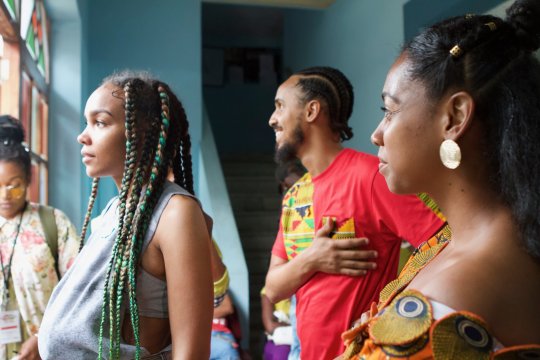
According to Dr. Yvonne Chireau, "Hoodoo is an African American-based tradition that makes use of natural and supernatural elements in order to create and effect change in the human experience."

Hoodoo was created by African Americans, who were among over 12 million enslaved Africans from various Central and West African ethnic groups being transported to the Americas from the 16th to 19th centuries (1514 to 1867) as part of the transatlantic slave trade. The transatlantic slave trade to the United States occurred between 1619 and 1808, and the illegal slave trade in the United States occurred between 1808 and 1860. Between 1619 and 1860 approximately 500,000 enslaved Africans were transported to the United States.

From Central Africa, Hoodoo has Bakongo magical influence from the Bakongo religion incorporating the Kongo cosmogram, Simbi water spirits, and Nkisi and Minkisi practices. The West African influence is Vodun from the Fon and Ewe people in Benin and Togo following some elements from the Yoruba religion. After their contact with European slave traders and missionaries, some Africans converted to Christianity willingly, while other enslaved Africans were forced to become Christian which resulted in a syncretization of African spiritual practices and beliefs with the Christian faith.
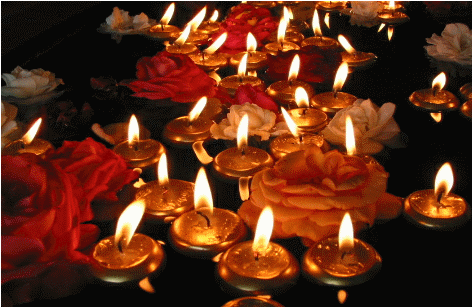
Enslaved and free Africans learned regional indigenous botanical knowledge after they arrived to the United States. The extent to which Hoodoo could be practiced varied by region and the temperament of the slaveholders. For example, the Gullah people of the coastal Southeast experienced an isolation and relative freedom that allowed retention of various traditional West African cultural practices. Gullah people and enslaved African-Americans in the Mississippi Delta, where the concentration of slaves was dense, Hoodoo was practiced under a large cover of secrecy. The reason for secrecy among enslaved and free African Americans was that slave codes prohibited large gatherings of enslaved and free African people. Slaveholders experienced how slave religion ignited slave revolts among enslaved and free African people, and some leaders of slave insurrections were African ministers or conjure doctors

#african#afrakan#kemetic dreams#africans#brownskin#afrakans#brown skin#african culture#afrakan spirituality#bakongo#congo#conjure#ancestor veneration#rootwork#hoodoo#nkisi#simbi#botanical#botanic garden#gullah#gullah geechee#gullah gullah island#mississippi#mississippi delta#slave codes#vodun#cosmogram#yoruba#america#african american
200 notes
·
View notes
Text
some notes on specifically "middle eastern" (mashriqi + iran, caucuses, and turkey) jewish communities/history:
something to keep in mind: judaism isn't "universalist" like christianity or islam - it's easier to marry into it than to convert on your own. conversions historically happened, but not in the same way they did for european and caucasian christians/non-arab muslims.
that being said, a majority of middle eastern jews descend from jewish population who remained in palestine or immigrated/were forced (as is the case with "kurdish" jews) from palestine to other areas and mixed with locals/others who came later (which at some point stopped). pretty much everywhere in the middle east and north africa (me/na) has/had a jewish population like this.
with european jews (as in all of them), the "mixing" was almost entirely during roman times with romans/greeks, and much less later if they left modern-day greece/italy.
(none of this means jewish people are or aren't "indigenous" to palestine, because that's not what that word means.)
like with every other jewish diaspora, middle eastern jewish cultures were heavily influenced by wherever they ended up. on a surface level you can see this in things like food and music.
after the expulsion of jews from spain and portugal, sephardim moved to several places around the world; many across me/na, mostly to the latter. most of the ones who ended up in the former went to present-day egypt, palestine, lebanon, syria, and turkey. a minority ended up in iraq (such as the sassoons' ancestors). like with all formerly-ottoman territories, there was some degree of back and forth between countries and continents.
some sephardim intermarried with local communities, some didn't. some still spoke ladino, some didn't. there was sometimes a wealth gap between musta'arabim and sephardim, and/or they mostly didn't even live in the same places, like in palestine and tunisia. it really depends on the area you're looking at.
regardless, almost all the jewish populations in the area went through "sephardic blending" - a blending of local and sephardic customs - to varying degrees. it's sort of like the cultural blending that came with spanish/portugese colonization in central and south america (except without the colonization).
how they were treated also really depends where/when you're looking. some were consistently dealt a raw hand (like "kurdish" and yemenite jews) while some managed to do fairly well, all things considered (like baghdadi and georgian jews). most where somewhere in between. the big difference between me/na + some balkan and non-byzantine european treatment of jews is due to geography - attitudes in law regarding jews in those areas tended to fall into different patterns.
long story short: most european governments didn't consider anyone who wasn't "christian" a citizen (sometimes even if they'd converted, like roma; it was a cultural/ethnic thing as well), and persecuted them accordingly; justifying this using "race science" when religion became less important there after the enlightenment.
most me/na and the byzantine governments considered jews (and later, christians) citizens, but allowed them certain legal/social opportunities while limiting/banning/imposing others. the extent of both depend on where/when you're looking but it was never universally "equal".
in specifically turkey, egypt, palestine, and the caucuses, there were also ashkenazi communities, who came mainly because living as a jew in non-ottoman europe at the time sucked more than in those places. ottoman territories in the balkans were also a common destination for this sort of migration.
in the case of palestine, there were often religious motivations to go as well, as there were for some other jews who immigrated. several hasidic dynasites more or less came in their entirety, such as the lithuanian/polish/hungarian ones which precede today's neutrei karta.
ashkenazi migration didn't really happen until jewish emancipation in europe for obvious reasons. it also predates zionism - an initially secular movement based on contemporaneous european nationalist ideologies - by some centuries.
most ashkenazi jews today reside in the us, while most sephardic or "mizrahi" jews are in occupied palestine. there, the latter outnumber the former. you're more likely to find certain groups (like "kurds" and yemenites) in occupied palestine than others (like persians and algerians) - usually ones without a western power that backed them from reactionary antisemitic persecution and/or who came from poorer communities. (and no, this doesn't "justify" the occupation).
(not to say there were none who immigrated willingly/"wanted" to go, or that none/all are zionist/anti-zionist. (ben-gvir is of "kuridsh" descent, for example.) i'm not here to parse motivations.)
this, along with a history of racism/chauvinism from the largely-ashkenazi "left", are why many mizrahim vote farther "right".
(in some places, significant numbers of the jewish community stayed, like turkey, tunisia, and iran. in some others, there's evidence of double/single-digit and sometimes crypto-jewish communities.)
worldwide, the former outnumber the latter. this is thought to be because of either a medieval ashkenazi population boom due to decreased population density (not talking about the "khazar theory", which has been proven to be bullshit, btw) or a later, general european one in the 18th/19th centuries due to increased quality of life.
the term "mizrahi" ("oriental", though it doesn't have the same connotation as in english) in its current form comes from the zionist movement in the 1940s/50s to describe me/na jewish settlers/refugees.
(i personally don't find it useful outside of israeli jewish socio-politics and use it on my blog only because it's a term everyone's familiar with.)
about specifically palestinian jews:
the israeli term for palestinian jews is "old yishuv". yishuv means settlement. this is in contrast to the "new yishuv", or settlers from the initial zionist settlement period in 1881-1948. these terms are usually used in the sense of describing historical groups of people (similar to how you would describe "south yemenis" or "czechoslovaks").
palestinian jews were absorbed into the israeli jewish population and have "settler privilege" on account of their being jewish. descendants make up something like 8% of the israeli jewish population and a handful (including, bafflingly, netanyahu and smoltrich) are in the current government.
they usually got to keep their property unless it was in an "arab area". there's none living in gaza/the west bank right now unless they're settlers.
their individual views on zionism vary as much as any general population's views vary on anything.
(my "palestinian jews" series isn't intended to posit that they all think the same way i do, but to show a side of history not many people know about. any "bias" only comes from the fact that i have a "bias" too. this is a tumblr blog, not an encyclopedia.)
during the initial zionist settlement period, there were palestinian/"old yishuv" jews who were both for zionism and against it. the former have been a part of the occupation and its government for pretty much its entire history.
some immigrated abroad before 1948 and may refer to themselves as "syrian jews". ("syria" was the name given to syria/lebanon/palestine/some parts of iraq during ottoman times. many lebanese and palestinian christians emigrated at around the same time and may refer to themselves as "syrian" for this reason too.)
ones who stayed or immigrated after for whatever reason mostly refer to themselves as "israeli".
in israeli jewish society, "palestinian" usually implies muslims and christians who are considered "arab" under israeli law. you may get differing degrees of revulsion/understanding of what exactly "palestine"/"palestinians" means but the apartheid means that palestinian =/= jewish.
because of this, usage of "palestinian" as a self-descriptor varies. your likelihood of finding someone descendent from/with ancestry from the "old yishuv" calling themselves a "palestinian jew" in the same way an israeli jew with ancestry in morocco would call themselves a "moroccan jew" is low.
(i use it on here because i'm assuming everyone knows what i mean.)
samaritans aren't 'jewish', they're their own thing, though they count as jewish under israeli law.
#jewish#mizrahi#palestinian jews#info#my posts#repost with more info#sorry if this isn't the best time to post it (?) then again this is my blog and i'm not indebted to anyone so (shrugs)#i've been seeing a lot of misinfo too so
334 notes
·
View notes
Note
do you think dornish religion is different to the rest of the seven?
Yes 100%
As I take the stance of "They still worship the Seven bc of colonization but its in a different fashion" I think its akin Central American Catholicism compared to Western European Catholicism. The idea that they syncretized aspects of the faith with worship of Mother Rhoyne. Festivals and ceremonies are veined through with folk imagery that's become part of the Dornish Seven Faith over the centuries. Traditional sacrifices, rites, dances, and other forms of worship have been adapted to include the new gods. Example: old Dornish fertility goddesses have been substituted by the Mother, who has taken on the traits of those old deities that the Andals did not originally give her.
#asoiaf#asoiaf worldbuilding#basically the very idea of Mexican folk catholicism#combining traditional practices into the forced colonial ideals to keep the old ways alive in some sense
117 notes
·
View notes
Note
do you know or have thoughts on why the dm characters sometimes reference ‘hell’ (as in ‘what the hell?’) given how the series handles religion? is that an anime thing or translation thing or…???
This is such a great question, and fun to answer, so thank you for writing to me!!! I think there's two things happening at the same time: What does hell really mean in English, and what are the characters actually saying in the original Japanese?
If the characters say hell in the original manga or in any translations, I think it is pretty safe to assume that they aren't referring to the Christian hell specifically, since it doesn't appear to exist in the Dungeon Meshi world. They are instead referring to the generic concept of a hell.
NON-CHRISTIAN HELLS
Hell is a word that can refer to a "bad afterlife" in many different world cultures. Obviously all of these cultures have their own names for these places, but when they are translated into English they are frequently referred to as "Buddhist hell", "Hindu hell", "Nordic hell", etc.
The word "hell" was adopted by Christians to describe something in their religion, but does not originate with them.
The modern English word hell is derived from Old English hel, to refer to a nether world of the dead. The word has cognates in all branches of the Germanic languages, and they all ultimately derive from the reconstructed Proto-Germanic feminine noun xaljō or haljō ('concealed place, the underworld'), and can be traced back even further to Proto-Indo European.
When the Germanic peoples were converted to Christianity, the word "hell" was adopted to refer to the Christian underworld. Before that time, hell was called many different things by the Christians, including "Sheol" (grave, death, pit, underworld), "Gehenna" (valley of wailing), "Hades" or "Tartarus." (The first two are Hebrew words, and the latter two are Ancient Greek. All of these words are attempting to describe similar things, a bad afterlife.) These Germanic cultures (most of Northern, Western and Central Europe) are the primary cultural influence of Dungeon Meshi's Eastern and Northern Continents, where the story takes place, and where most of the characters are from. So the word hel/hell would be native to the region, and logical for the characters to use both as a swear word, and also as a reference to whatever afterlife they might believe in.
WHAT ARE THE CHARACTERS ACTUALLY SAYING THOUGH?
Dungeon Meshi is, for better or for worse, written in standard, contemporary Japanese, without any particular emphasis or attempt to sound "old fashioned" or like it is "fantasy", so any changes or additions made in translation to make the dialog or narration sound that way are just that: additions and changes. The changes made during translation aren't inherently bad, but the original text is very neutral, and open to interpretation. For example, Yaad calls Laios "tono/dono" in Japanese, which is an honorific that has no direct English equivalent, but is used between two people of similar social status, when one wants to be extra polite to the other. It does not imply nobility, but respect higher than "mister" and lower than "lord." Most English translations have rendered this as "Sir Laios" which isn't literally what Yaad says, but conveys the idea with something that "feels right" for the setting. It may be that in Dungeon Meshi the characters are literally saying the English word "hell/heru" in Japanese (ヘル), the word jigoku (地獄), which is the Japanese word for Buddhist hell, another word for a specific different underworld or afterlife, they are saying a Japanese swear word, or just using casual/impolite language that doesn't have a direct translation into English, and so needs to be localized into something that will make sense in English.
The last one is most likely what is happening, and I can think of a couple of common phrases that would most likely be translated into "What the hell?":
The polite, neutral way to say "What's that?" or "What [should I] do?" is "Nan-darou? (なんだろう?) or "Nani?" (何), which just means "What?"
The more casual, aggressive, masculine way of saying it is "Nani-kore?" (なにこれ?) which doesn't mention hell in any way, but translates to something like "What the hell?" or "What the fuck?" It's more rude because it's casual speech, but doesn't literally use words for hell or fuck in it. It technically means the same thing as "Nan-darou?" or "Nani?" But translating it the same way would be ignoring the context and tone of the words.
Another thing that's often said in Japanese is "Uso!" (うそ!) Which literally means "lie" or "not true", but in conversation it’s often used to say things like "you're lying!", "For real?!", "really?", or "No way!"
Often these exclamations of "Uso!" don't have anything to do with lying or untruths, they are meant to express surprise (this can't be happening!) or a response to someone talking about an outrageous and terrible event they experienced, like saying "No way! I can't believe that happened to you!" It's also sometimes translated as "What the hell…" or "Unbelievable…"
If the translators tried to keep this sort of thing literal, the manga would be full of lines like:
CHILCHUCK, running for his life from a mimic: What's this?! (Nani-kore?!) (He isn't literally asking what the mimic is, he is expressing surprise, so he should shout some curse words in English like hell, fuck, shit, etc.)
MARCILLE, horrified by the chimera: Lie! (Uso!) (She isn't just saying the word "lie" with no context, she is expressing shock, horror and disbelief at what she sees, so she should say something like "No, that can't be..." or "Impossible...")
I am not an expert in Japanese, but I hope that all of this is helpful to you, anon, and anyone else that's interested in this sort of thing!
57 notes
·
View notes
Note
excellent choice re: will’s new name!
now this is a lore question: was john’s mum from a different tribe than their dad? considering his name is from a different language and tribe than Will’s. we know Will’s mum’s origins, but not a lot on John’s mum. am i veering into lore book spoilers (is there such a thing)
So here's the beginning of the skinny on how Sunjata is organized. Like how my Avalon is loosely inspired by various Medieval-approximate European cultures, Sunjata is loosely inspired by various North-West-Central African cultures. Emphasis on the "loosely inspired" for both nations.
Sunjata is a continent of city-states that has a strong emphasis on technology and trade. It is more technologically advanced than Avalon, with things like aquaduct systems (and more modern-style plumbing!) and dynamite.
The thing that unites Sunjata is a single religion and a single language. Hundreds of years ago, it is said that the god Amun devoured all the other gods, ending their constant battles against one another. With his greatly enhanced divine power, Amun blessed the bloodlines of his most devout worshippers, essentially giving them superpowers. These Blessed Bloodlines went on to conquer the continent and found the great city states that rule over Sunjata today. With the common religion and its conquests came a massive upheaval/movement of people and a common language that swept across the continent (the holdout tribes who continue to worship the old gods are more likely to have held onto their traditional languages as well - these tribes hold the great heresy that Amun did not devour, but instead imprisoned their gods).
Names in Sunjata descend from its variety of pre-Amunite languages and tend to follow certain regional trends, but for Amunites they are no longer connected to specific tribal identities. Sunjati continue to have strong kinship ties, but their cultural identity is generally tied to their city-state and to the Amunite religion in general. Thus you'll have family members with names from different Earth African cultures, similarly to how North American names are a real cultural mishmash (In my own family, my name derives originally from Hebrew and my sister's from Greek, but they're both considered standard American names - Sunjata at this point in history is similar).
That said, John's mother was not from his village. His father travelled often as the village chief, negotiating trade agreements with merchants in the larger settlements and the city-states. He met her on one of those journeys, just as he met Will's mother years after her death.
I haven't yet put together the finer details of Sunjati culture as I plan to do a lot more reading, research, and consultation before writing my second game (set in Sunjata with a Sunjati MC).
23 notes
·
View notes
Text
High Fantasy Conundrums: The Misunderstanding of Religion

Talking about the cultural diversity within High Fantasy settings, and how they usually convert at a vague idea of a "medieval Europe", that is not really connected to the actual historical medieval Europe, religion is the topic that cannot be avoided. And yet... High Fantasy often enough tries to avoid this topic often enough. At least outside of the TTRPG settings.
I spoke on that yesterday already. There is the issue of Christianity. Because medieval Europe was molded both by some of the older European cultures, and the way that Christianity related to them and took this central role within society. A role that was quite different from what either media tries to display, mind you. But a role that was never the less central.
But High Fantasy kinda struggles to deal with this. Because if we are honest, media in general struggles with dealing with the church and Christianity in a complex matter. And if you worldbuild around it, you need to be a bit more complex.
Usually High Fantasy worlds work with either of these ideas:
"Church? Religion? What?"
"There is a church. There totally is. Don't worry."
"There is this big ass pantheon and everyone agrees on that. Actually, look, there is one of the gods walking around. Hi, God!"
Ironically Tolkien was always an example of the first. Sure, there are gods in Middle Earth, as well as creatures that work like angels and stuff. But, like... Religion does not really play a role within the story. The characters in Lord of the Rings do not really care about gods, and for the most part, there is not a lot of religious worship happening in the world. And because Lord of the Rings was so influencial on the genre, this was actually true for a lot of High Fantasy that followed.
Yes, there were gods. In most worlds there were gods of some sort, if we ever learn how the world or the magic works. But it is rare that the characters actually care about those gods. Heck, in quite a few examples it is not even clear if anyone even knows about the gods, let alone worships them.
The next method, that came up in quite a few stories, is that, yeah, there is a church. There is a church. And yeah, sure, like, the characters do believe in a god or a religion. It just... does not matter. It might color their language a bit, and maybe there are some characters in there that have a relation to the church, but it still does not really go into it. It exists on the margins of the story, but it never plays a central role. Often we do not learn much of what the religion is actually about.
And then there is the last one. The one that we will usually see in most TTRPG settings, but also in quite a few other High Fantasy settings: There is a pantheon, which often enough is actually prooven to be real. Because we can observe the gods interacting with the world they exist in. Both directly and through their clerics/priests.
How that pantheon works will differ greatly, but it is pretty much always a pantheon with a variety of gods. And outside of the worship of this pantheon, there is not much in terms of religion happening in the world.
Here is the issue, of course: All those ways of depicting religion within those worlds are very much based in a worldview informed by the writers living in a Christian majority world, that is however not centrally controlled by this religion anymore, though constantly influenced by it.
Alright, unpopular opinion time: Most Christians are actually really bad at their religion. They are. They lack understanding of the context of their religion. And while they will know some stories from the bible, few will actually have read the whole thing. They also do not understand or want to understand the history of both the selection of the stories in the bible - or the translation of it.
The more left-leaning, progressive Christian leans into the feel-good messages of Jesus. The more conservative Christian will more look for the ways in which there is stuff in the bible allowing him to hate the gays or the Blacks. But neither will really engage with the context of it. And it is not their fault. The fault is in the fact that we as a society get actively disencouraged from questioning religion and however it might be presented - mostly under the pretense of "respecting everyone's believes".
This leads to the aversion of many writers to interact with Christianity, Christian mythology and Abrahamitic religion in general in terms of writing. Especially when it comes to including those things into fantasy settings.
And this aversion makes dealing with religion within a High Fantasy world awkward. Because to build religion into the High Fantasy world, one would have to question and understand the role that religion played in actual history. And that, yeah... It is uncomfortable. Because we have been raised to feel uncomfortable about that. So often enough we don't.
It is uncomfortable in a different way for a believer than it is to a non-believer. Tolkien, who was a Christian, had clearly very different thoughts on it, than some modern writer might have. But it is uncomfortable never the less.
Then there is the other aspect that fantasy has to deal with - and struggles with because of the modern perspective. As I said, Dungeons & Dragons, Pathfinder and quite a few other settings choose to go with a pantheon of gods that are real. So everyone everywhere is united in agreeing that those gods are real, nobody ever argues about that, and while some might like some gods more than others (especially in DnD, where some gods are villains), the pantheon is worshipped as a whole.
The argument goes: "Who would be so insane to doubt those gods, if there is observable proof of them existing?" But that argument... actually does not work.
Because that argument focuses on the perspective of the heroes of the stories, who in their role as heroes actually do get to interact with the gods. Most farmers have never seen any of the gods do shit. They might have seen a cleric a couple of times, who might even have done magic, but, no shit, other people do magic too without relating it to one of the gods. Especially in DnD, which is a High Magic world in general, those gods do appear a lot less impressive, right?
And here is the other thing. There are stories going around in the world of DnD (and other fantasy worlds with comparable worldbuilding) about the gods coming down to Earth and doing their thing. But the same is true for the real world. Especially in historical times there were so many stories of saints appearing, of actual gods from the actual polytheistic pantheons appearing, of magic happening. There was supposed proof of that happening, and still not everyone was sold on those religions - and there were other religions happening.
Which brings me once again back to the lack of any cultural diversity and this focus on the one culture. Because... this is also connected to it.
For one: Different cultures do worship different sorts of gods. And even if they worship the same god, they might worship that god in very different ways. That is just something that will happen to any religion - and I do not think that most gods will be terribly interested in clearing up misunderstandings all the fucking time, even if those gods are real.
In worlds like Toril, where there definitely are other religions around on the other continents - and where there were other gods around in times past... One would think that this should somewhat show. Sure, the people would come to accept the Faerûnian gods, if they are living in Faerûn. Maybe. But they might still worship their own gods. And maybe they will mix it up, if you get what I mean. And this should show with the races, too. Elves, halflings, dwarves and so on might also worship the gods in different ways.
This is one of those core issues.
Neither of those three ways that High Fantasy usually deals with religion actually works. And more than anything it really does show the influence of the culture people grew up in.
And, well... I still think we can do better in that regard.
#high fantasy#fantasy worldbuilding#fantasy worlds#religion#Christianity#the church#history#worldbuilding#dungeons & dragons#dnd#lord of the rings#pathfinder#ttrpgs#baldur's gate 3#baldurs gate 3#bg3
39 notes
·
View notes
Note
there was Chinese interest in the Out Of Asia theory, in both the Republic, Chiang Republic and People’s Republic periods before the Out Of Africa theory became commonly accepted. Was the 1954 Yeti expedition done just from the Nepalese-Indian side or were the American agents and “anthropologists” given access on the Sino-Tibetan side of the Himalayan border?
During the early part of this century, it was absolutely believed for a long time that the deserts of Western China were the most likely place of human origins, as seen in this migration map from 1944, made from the best available knowledge of the time:

Remember, the oldest fossil remains at this point were in China, where Homo erectus was discovered (originally known by his initial place of discovery in Chungkotien Cave, nicknamed "Peking Man"). The discovery of Australopithecus and Homo habilis in Olduvai Gorge and South Africa, which place human origins in Africa, were not until the 50s and 60s, so it seemed entirely reasonable that Homo sapiens evolved in Western China.
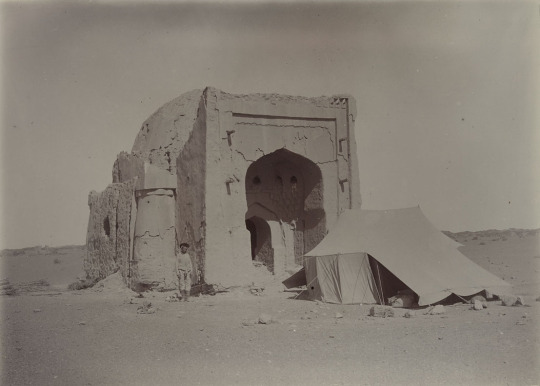
The idea that China's desert regions were the origin of modern humans and culture is seen a lot in pop culture from 1900-1950, mainly because there were tremendous explorations in the region, especially Aurel Stein's expedition of 1908, who ventured into the Taklamakan Desert to find the Dunhuang Caves and Khara-Khoto, a city destroyed completely by Genghis Khan and vanished in the desert.

If you've ever heard of Roy Chapman Andrews and his famous expeditions in the 1920s, it's worth noting that he ventured into the Gobi Desert looking for human remains....not dinosaurs, and the discovery of dinosaur eggs was an unexpected surprise.


For that reason, there was a short lived Silk Road Mania that seemed to be a smaller scale predecessor to the pop culture dominating Egyptomania of the 1920s. It's bizarre to read adventure and fantasy fiction of the 1910s-1920s that features mentions of Silk Road peoples like the Kyrgyz, Sogdians, Tajik, Uigurians, and Tuvans. The best example I can think of would be the Khlit the Kossack stories of Harold Lamb (who also wrote a biography of Tamerlane), which together with Tarzan and Tros of Samothrace, formed the core inspiration for Robert E. Howard's Conan the Barbarian.
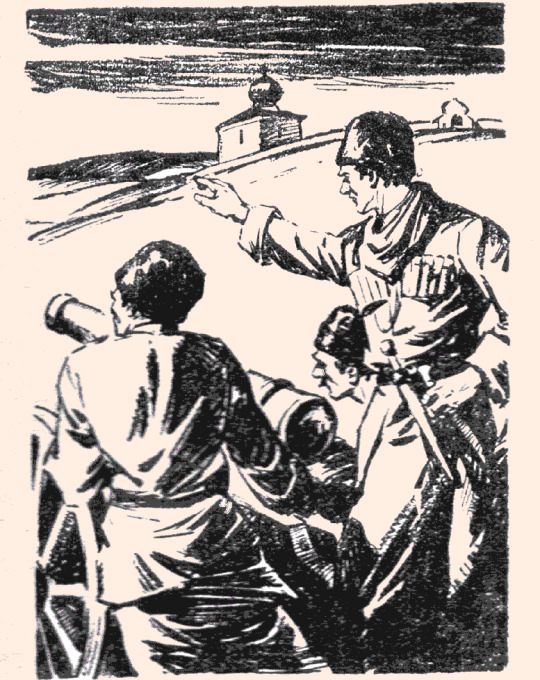
The most interesting example of this would be A. Merritt's Dwellers in the Mirage, which featured a lost city in Xinjiang that was the home of the Nordic race, who worshipped their original religion, the kraken-like squid devil god Khalkru. It was widely believed in this era that Nordics emerged from Central Asia originally, and while it's easy to write this off as turn of the century racialist claptrap pseudohistory (along with Hyperborea legends), in this case, it is actually true: a branch of the Indo-European family lived in West China, and 5,000 year old redheaded mummies have been found in the region. As usual, A. Merritt was right on the money with his archeology, more so than other 1920s authors. After all, his "Moon Pool" was set around the just discovered ruins of Nan Madol, the Venice of Micronesia.
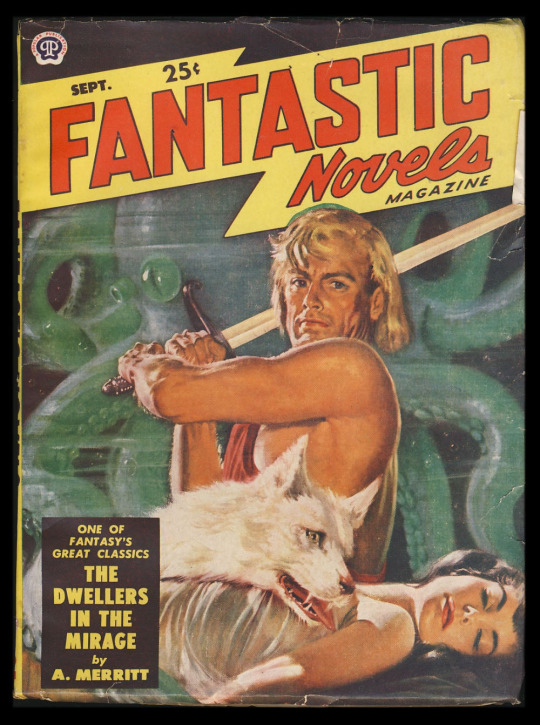
Jack Williamson's still chilling Darker Than You Think in 1948 was also set in the Silk Road/Central Asian region, as the place the race of shapeshifters emerged from, Homo magi, who await the coming of their evil messiah, the Night King, who will give them power over the human race.
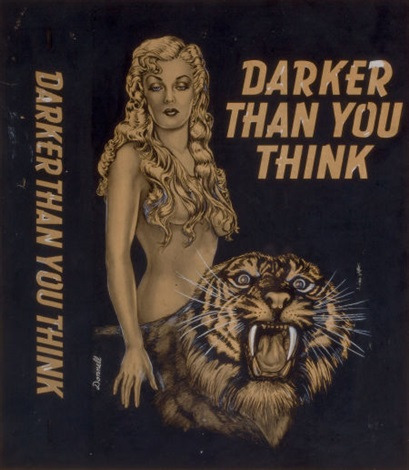
H. Rider Haggard set "Ayesha: the Return of She" (1905) in Xinjiang, among a lost Greek colony in Central Asia (no doubt based on Alexandria on the Indus, a Greek colony in modern Pakistan that was the furthest bastion of Greek Culture). This was also two years after the Younghusband Thibetan Expedition of 1903, where the British invaded Tibet. At the time, the Qing Dynasty was completely declining and lost control of the frontier regions, and the power vacuum was filled by religious authority by default (this is something you also saw in Xinjiang, where for example, the leader of the city was the Imam of Kashgar).
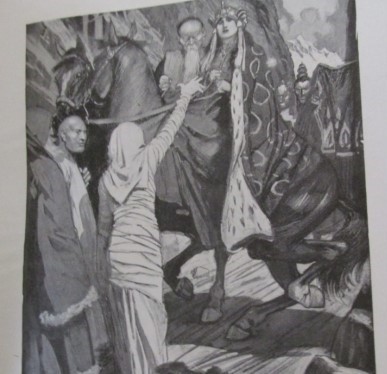
This is one of the many British invasions they have attempted to cram down the memory hole, but if you ever see a Himalayan art piece that was "obtained in 1903-1904" ....well, you know where it came from.
Incidentally, there's one really funny recent conspiracy theory about paleontology, fossils, and China that I find incredibly interesting: the idea that dinosaurs having feathers is a lie and a sinister plot spread by the Communist Chinese (who else?) to make American youth into sissy fancylads, like Jessie "the Body" Ventura. How? By lying to us and making up that the manly and vigorous Tyrannosaurus, a beast with off the charts heterosexuality and a model for boys everywhere, might have been feathered like a debutante's dress. What next - lipstick on a Great White Shark? The long term goal is to make Americans effeminate C. Nelson Reilly types unable to defend against invasion. This is a theory that is getting steam among the kind of people who used to read Soldier of Fortune magazine, and among abusive stepfathers the world over.

...okay, are you done laughing? Yeah, this is obvious crackpottery and transparent sexual pathology, on the level of the John Birch Society in the 60s saying the Beatles were a Communist mind control plot. Mostly because animals just look how they look, and if it turned out that the ferocious Tyrannosaurus had feathers and looked like a fancylad Jessie Ventura to you, well, that's your problem and mental baggage, really.
I was left scratching my head over this one. But there is (kind of) something to this, and that is that a huge chunk of recent dinosaur discoveries have been in China. I don't think it has anything to do with a Communist plot to turn American boys into fancylads, but more to do with a major push in internal public investment in sciences in that country, and an explosion of Chinese dinosaur discoveries. If you want to see a great undervisited dinosaur museum, go to the Zigong Dinosaur Museum in Sichuan.

Pop quiz: what living scientist has named more dinosaur discoveries? It's not Bakker or Horner. The greatest living paleontologist, Xu Xing, which is why a lot of recently found dinosaurs are named things like Shangtungasaurus.
252 notes
·
View notes
Text
“Forests are probably the closest thing to religion we have,” says Lisett Luik, a founder of Arbonics, one of these startups. “If you think of central European fairytales, forests are dark places where bad things happen; in Estonia, forest is where you go for safety.”
16 notes
·
View notes
Photo

Nih'a'ca Tales
Nih'a'ca tales are Arapaho legends concerning the trickster figure Nih'a'ca, who, according to Arapaho lore, is the first haxu'xan (two-spirit), a third gender, often highly regarded by many Native American nations, including the Arapaho. The Nih'a'ca tales are similar to the Wihio tales of the Cheyenne and the Iktomi tales of the Sioux.
North American Panther
Rodney Cammauf /National Park Service (Public Domain)
Circumstances and situations differ between the Nih'a'ca tales and those concerning trickster figures of other Native peoples of North America, but the central character of the trickster plays the same role – sometimes as sage and mediator, sometimes as schemer and villain – in them all. In the case of Nih'a'ca – always referred to by the male pronoun in English translations of Arapaho tales – he is frequently depicted in legend as someone who tries to better himself, usually at the expense of others or by trying to take shortcuts, and suffers for it.
At the same time, Nih'a'ca can be wise, offering advice, or clever, as in the story Nih'a'ca Pursued by the Rolling Skull, in which he must find a way to escape death. His identity as a haxu'xan is often, though not always, central to the story's plot – as in Nih'a'ca and the Panther-Young-Man where he, identifying as a woman, marries a panther – and, in stories where his gender is highlighted, serves to teach an important cultural, moral, lesson.
The Nih'a'ca tales are still told in Arapaho and Cheyenne communities, as well as others – including LGBTQ organizations – not only for their entertainment value but for the lessons they offer on personal responsibility and the proper respect and treatment to be shown to others. Like the trickster figures of other nations, Nih'a'ca is often depicted as, or associated with, the spider – spinning webs to catch others which often wind up entangling himself.
The Two-Spirit & Nih'a'ca
Two-Spirit is a modern designation, coined as recently as 1990, for the third gender recognized by many Native American nations for centuries before their contact with European immigrants. Because the term is so new, the two-spirit is often, incorrectly, assumed to be a recent 'discovery' made by anthropologists when, actually, European accounts going back to 1775 reference a third gender among North American Native peoples and the oral histories, myths, and legends – like the Nih'a'ca tales – also attest to the long-standing recognition of two-spirits in a given community.
As the term implies, a two-spirit is someone who recognizes both a male and female spirit dwelling within and often, though not always, dresses in the clothes and performs the duties of their opposite biological sex. Because they are understood as both male and female, two-spirits are recognized as possessing especially keen insight and often serve as mediators – in the present as they did in the past – in resolving personal or communal disputes. They were, and are (or can be), also regarded as holy people – "medicine men" and "medicine women" – serving as mediators between the people and the spirit world. Scholar Larry J. Zimmerman comments:
The relationship between a holy person and the spirit world is almost that of a personal religion. The first meeting with the spirits becomes the personal myth, and the power of this myth is important for establishing the holy person's credentials with the tribe, on behalf of which his or her skills are used to locate game, find lost objects, and, above all, treat the sick. The holy person can enter a trance at will and journey to the sacred world.
(132-133)
While Nih'a'ca is sometimes depicted as a holy person, he is more often quite the opposite, possessing characteristics such as selfishness, cruelty, and a blatant disregard for cultural norms. Through the Nih'a'ca tales, which frequently conclude with the central character suffering for his misdeeds, higher values including selflessness, kindness, and respect for tradition and the feelings of others are highlighted.
Nih'a'ca, then, usually serves as an exemplar of bad behavior and is given the identity of a two-spirit – in fact, the first two-spirit in the world – because the recognition of the sacred aspect of the two-spirit further emphasizes just how misguided Nih'a'ca's choices and actions can be. The tales themselves are a kind of 'trickster' turning expectations upside down and, in so doing, offer an audience the opportunity for reflection on their own behavior and the possibility of transformation.
Continue reading...
63 notes
·
View notes
Text

Roman Goddess Luciana of Childbirth and Light
Attributes:
Childbirth
Matrons (Married Women)
New borns
Midwifery
Soon - to - be Mothers
Virginity/Chasity
Celestial Light Moon and Sun
Light that which brings Newborns into life.
Fertility especially when it comes to women
Symbols:
Torches
The colors red, black, and white
Libyan Lotus trees or Nettle trees. Member of the Elm tree family. The trees are southern European species of nettle trees, the Romans just refer them to as Lotus trees.
I’ve read from a source that lady bugs or lady birds are sacred to her but I find just one source so take it with a gain of salt. Lady bugs is mostly associated with Freyja so I would imagine relating to fertility.
Titles and Epithets:
Luciana is the Goddess of light and childbirth and newborns. Her name is alone to be just be a goddess alone which is possibly she originated from a Sabine moon goddess. But her name itself can be a title like how “Hekate or Hekatos” is used not just for a name of a goddess. Her name Luciana can be derived from the Latin word “Lux” which is luminous and light also “Lucus” which means Groves I’ll explain in the next paragraph. I’ll put other names she was referred by but also what goddesses of which they took her name as an epithet/title.
- Noctiluca - Giving Light by Night
- Luna - Of The Moonlight
- Lucifera - Giver of Light
- Juno Lucina - Shining one. With this title there is more information about the worship of Luciana.
- Diana Lucina - Divine Queen
- Hekate Lucina - Hekate was also known to bear this title as a light bearer.
- Saint Lucia or Saint Lucy: It is theorised and not so uncommon of when goddesses or gods become saints after Christianisation a well known example is St Brigid once known before in pre-Christian Ireland as a Celtic goddess of the Hearth. Saint Lucia is said to be the Goddess of Luciana whose symbol is a torch as well.
General Information
During the early days of the Roman Empire Luciana was one of the first temples to be established. She is said to be originated from the tribe of Sabine whose role as a moon goddess. Her role within Roman religion was mostly documented as Juno Lucina which isn’t surprising since Juno is the goddess of marriage and motherhood and childbirth. Her temple was set on Cisipan Hill on a Grove. But a shrine to Luciana was built on Esquiline Hill around 373 BCE on March 1st. It was always set on a grove which was surrounded by Lotus trees or Nettle trees which was very sacred and celebrated by offering locks of hair from Vestal Virgins who acknowledge their vows of chastity and a choice to not become a mother.
When Luciana was invoked during childbirth for easy delivery and a healthy child to be born. Women would let their hair loose and untie any knots from their clothing in a way of sympathetic magic letting energy of the birth flow easily and without any complications. After the baby was delivered, the child would be brought to the goddess’s altar called Sellisternium (a altar dedicated to a goddess) along for a feast of celebration. Luciana is very much centered around all things pregnancy, newborns, fertility, she even is called a Saviour from infertility, She is in charge bringing Newborns into the light of the world, also grants Newborns safe passage.
Her festivals
Held on March 1st, the Roman new year also called Matronalia plus the anniversary of the temple’s founding. Where married women would be given money from their husbands to make an offering to Juno Luciana of Womanhood. They (Matrons) would general go to the temple make offerings on Esquiline Hill. Afterwards a festival of Family would began as the Matrons of the household would be a central figure with their husbands giving them gifts and Slaves would be served as well.
Editor’s Note:
It was brought up very importantly that Luciana is the Italian proper name but “Lucina” is the correct and proper spelling for the titles and epithets for Juno and Diana not Luciana. The difference is very hard to notice at first which I made that mistake, but thank you to the lovely user who made it known to me in the comments! Putting this here so that it’s a marking of update, I will retype the titles and such for the correction 💖
#hellenic polytheism#paganism#hellenic pagan#italian traditions#italian folk magic#roman paganism#roman goddess#helpol#hellenic community#witchcraft
21 notes
·
View notes